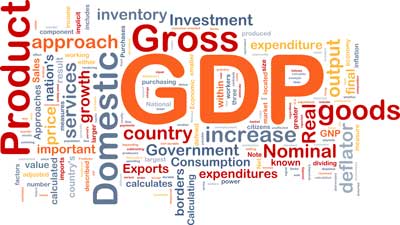More
It is important to distinguish between nominal GDP and GDP measured in fixed prices. Assume that a country produces only two goods: mobile telephones and cars. During the first year 1 million telephones and 200,000 cars are produced. One telephone costs €200 and one car costs €30,000. This means that GDP for year 1 will be:
- 1,000,000 telephones @ €200 + 200,000 cars @ €30,000= €200M + €6,000M= €6,200M.
Nominal GDP for the year will thus be 6.2 billion Euros.
Assume that during the second year 1.2 million telephones and 210,000 cars are produced. At the same time, the price of a telephone increases to €220 and of a car to €33,000. GDP for year two will then be:
- 1,200,000 telephones @ €220 + 210,000 cars @ €33,000= €264M+€6,930M= €7,1940M.
Nominal GDP for year two will thus be nearly 7.2 billion Euros, which is an increase of over 16%. But this increase depends partly on an increase in volume and partly on an increase in price. Calculating GDP with fixed prices will correct for the price increase between the two years. We take the volumes from year two and the prices from year one. GDP with fixed prices will be:
- 1,200,000 telephones @ €200+210,000 cars @ €30,000= €240M+ €6,300M = €6,540M.
GDP for the second year will instead now be approximately 6.5 billion Euros. This is an increase of 5.5%, which shows a significantly lower growth as compared with the increase in nominal GDP. The difference also shows that the manufacturers have succeeded in increasing their prices in parallel with the increase in volume -- inflation-driven growth.
GDP is used principally to see the growth in a specific country from one period of time to another. But GDP per capita is also used to compare growth and living standards between countries.
Measuring by comparing numbers between countries has its deficiencies, however, and is subject to a great deal of criticism. The most important objection is that not all production is included in GDP -- e.g., all "do-it-yourself-jobs", unpaid, non-profit or black-market work is not included.
Another deficiency is that it is difficult to determine the value of the public sector's production. This is taken at what it costs, not at the value it delivers. But despite these deficiencies GDP is an accepted, established and much used measure.



